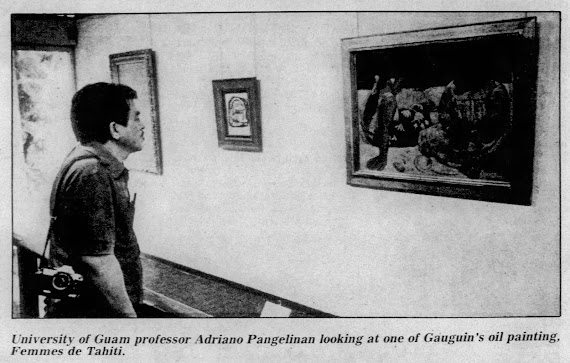Adios Tun Adriano
Last month, Tun Adriano Baza Pangelinan, a pioneering Chamoru artist and former professor at UOG passed away. I met Tun Adriano many times over the years, primarily when I was an art major at UOG.
Tun Adriano was always an intimidating figure. My art professors such as the late Joe Babauta and Ric Castro, were both confident and outspoken, but became very circumspect and respectful when Tun Adriano was around. He wasn't the first Chamoru to paint or draw in a modern sense, but he was one of the first Chamoru artists to blend artistic styles from famous European movements like Fauvism and Impressionism with local culture and life.
That blending and refusal to accept binary choices was pioneering. It wasn't too long ago that Chamorus felt that in order to achieve anything in life they need to give up their culture, their heritage, their island. This was part of how the United States entered into Guam, filling the island with demoralizing ideas in that whatever was local had nothing to offer, and success and prosperity relied upon leaving the local behind and embracing whatever came from elsewhere.
For example, if you wanted to be an artist you needed to emulate the greats from Europe, from the US, paint like them, paint what they painted. In his career, Tun Adriano proved that to be a false choice. He didn't give up his connection to this island into order to be an artist, but used his roots to give beauty and power to both, himself as a Chamoru and also himself as an artist.
Although I never got to have any extended conversation with Tun Adriano while he was alive, I remember one experience that profoundly impacted me. As I’ve shared in my columns before, I am someone who actively teaches, studies and promotes the Chamoru language today, but this wasn’t always the case. I did not grow up speaking Chamoru, and to be honest didn't care much for my identity as a Chamoru or being from Guam until I was attending UOG. In my last year of undergrad I started to take Chamoru and convinced my grandparents to help me learn it. That experience changed my entire trajectory in life.
In the first year or two of me learning to speak Chamoru, I recall seeing Joe Babauta and Tun Adriano speaking outside and drinking during an art exhibit opening. Both of them were known for being highly critical and even blunt when dealing with students and other artists. As an art major, I recall receiving quite a few tongue-lashings from Babauta when he would offer critiques of my paintings or drawings in class.
I stood near them while they were talking, in Chamoru about the art in the show. I didn't have enough Chamoru knowledge to be able to join the conversation, but I remember feeling incredibly inspired by what I was hearing. Two Chamoru artists, talking about contemporary art in the Chamoru language.
There are many who still feel that contemporary art isn't Chamoru or that to engage in it, you have to leave behind your island, culture and roots. But for me the lesson was and remains clear, just as you shouldn't apologize for being an artist, don't apologize for being Chamoru.
Si Yu’os Ma’åse Tun Adriano. U såga gi minahgong.




Comments